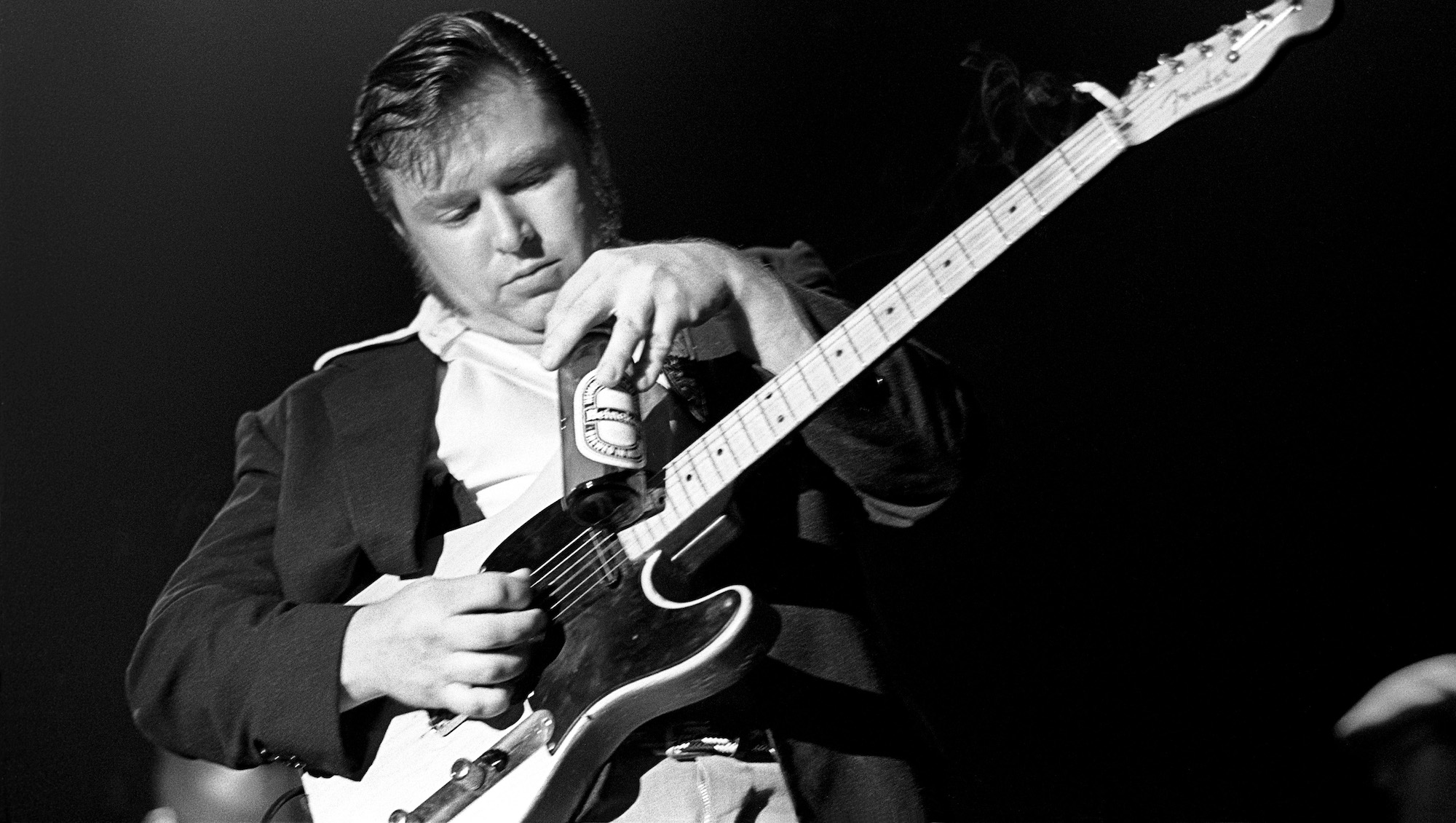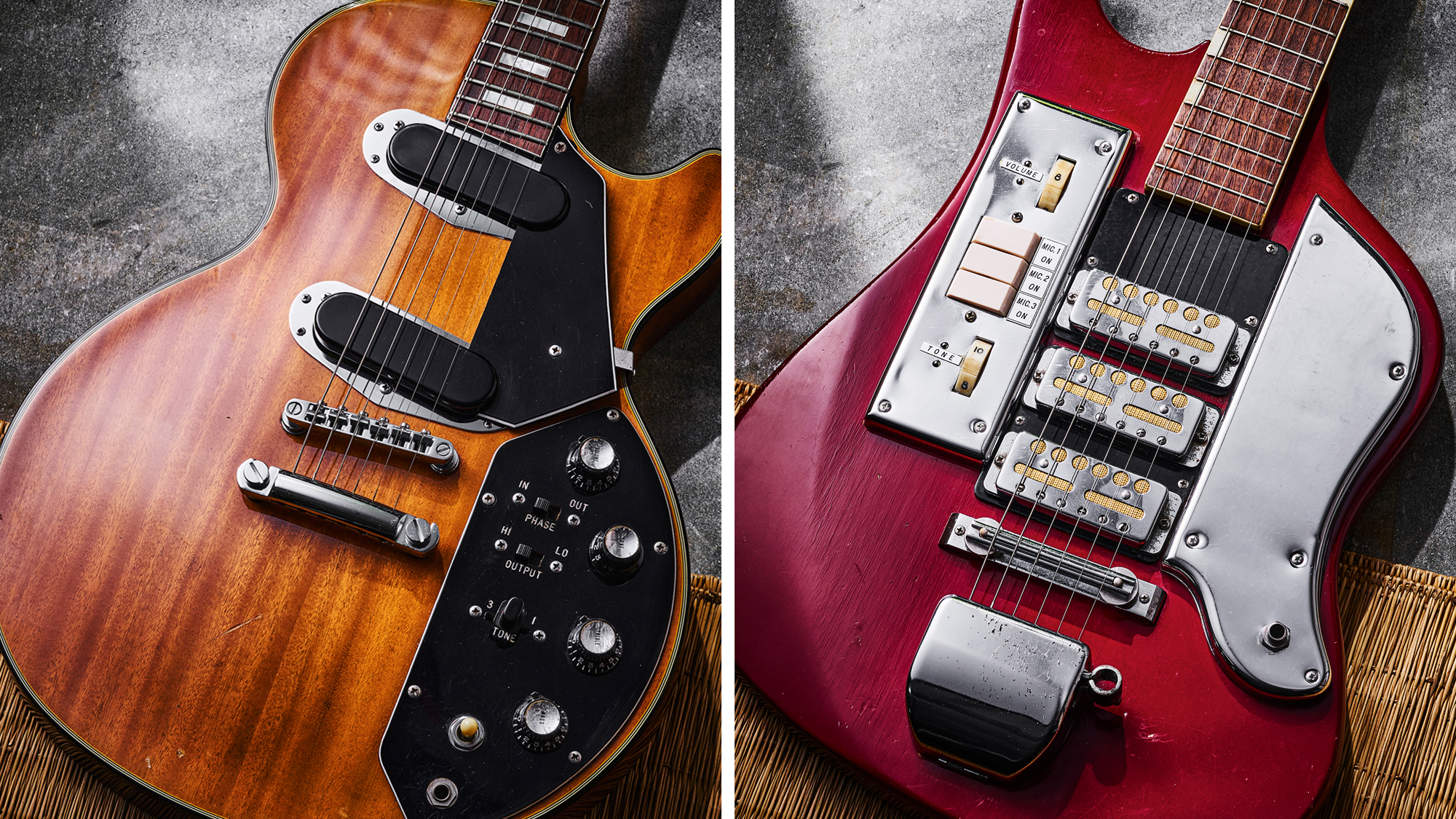The 50 greatest guitar solos of all time
The best lead playing ever committed to record, as voted by you
10. Crazy Train – Ozzy Osbourne (Guitarist: Randy Rhoads, 1980)
The Double O has often cited Randy Rhoads as the man who saved his career – and when you hear solos like Crazy Train, it’s easy to understand why. He didn’t sound much like Tony Iommi, being more classical and modal than blues-based, but like Ozzy’s old bandmate he was a true inventor.
There’s a section towards the end of this solo that actually sounds like a train squealing off the tracks thanks to the use of a chromatically ascending trill that then descends in key.
Rhoads then chose to end the solo with a fast-picked F# minor pentatonic phrase before a rapid Aeolian legato run ending with a big bend on the 19th fret. Sadly, he only recorded two studio albums with Ozzy, tragically passing away in a plane crash at the age of 25.
9. Beat It – Michael Jackson (Guitarist: Eddie Van Halen, 1982)
When Eddie Van Halen went turned up to the studio where Michael Jackson and Quincy Jones were making Thriller and enquired as to what exactly they were after, he was told to just play whatever he wanted.
Two takes and 20 minutes later, the shred guitar pioneer was done – having reworked the solo section to suit his unique style of playing. “I was just finishing the second solo when Michael walked in,” Eddie told CNN in 2012. “So I warned him before he listened. I said, ‘Look, I changed the middle section of your song.’ He gave it a listen, turned to me and went, ‘Wow, thank you so much for having the passion to not just come in and blaze a solo, but to actually care about the song.’
8. Free Bird – Lynyrd Skynyrd (Guitarist: Allen Collins, 1974)
At 143 bars long, Free Bird’s solo is far and away the most epic offering here (in fact, it’s 286 bars of recorded music because the whole thing is doubled!). Appearing on the group’s eponymous debut album in 1973, guitarist Allen Collins delivered the lot on his 1964 Gibson Explorer.
As Lynyrd Skynyrd’s Gary Rossington once told Guitar World, “The whole long jam was Allen Collins himself. He was bad. He was super bad! He was bad-to-the-bone bad. When we put the solo together, we liked the sound of the two guitars, and I could’ve gone out and played it with him. But the way he was doin’ it, he was just so hot! He just did it once and did it again and it was done.”
Get The Pick Newsletter
All the latest guitar news, interviews, lessons, reviews, deals and more, direct to your inbox!
7. Sultans Of Swing – Dire Straits (Guitarist: Mark Knopfler, 1977)
On a cold, rainy evening in 1977, guitarist Mark Knopfler stepped into a Deptford pub where a group of old boys were playing Dixieland jazz to the complete indifference of the patrons. Their set closed, and they signed themselves off as the Sultans Of Swing.
The exotic majesty of their name clashed beautifully with the drab reality of their surroundings, and Knopfler was inspired. Originally composed on his trusty National steel guitar, it wasn’t until he plugged his 1961 Strat into bassist John Illsley’s Fender Vibrolux amp that Mark knew he really had something with this classic track.
Famed for its fast fingerpicked solo, Sultans’ outro licks essentially boil down to a couple of simple repeating four-note arpeggios, and, despite a relentless pace, Knopfler’s efficient picking method makes things easier. Just follow this pattern: thumb-pick the first string; play a pull-off; thumb-pick the second string; finger-pick the first string.
Don’t get it? Well, this approach means your thumb picks at half-speed – so you won’t run out of steam! After that, it’s just a matter of careful timing to fit the pull-off and finger-picked note in between your thumbed notes. The old adage of ‘practise slowly and gradually build speed’ applies!
6. Sweet Child O’ Mine – Guns N’ Roses (Guitarist: Slash, 1988)
There are many reasons why Slash’s lead work on this early Guns N’ Roses breakthrough single will be forever remembered as quintessential rock guitar at its finest. The first half of the solo is laid back and modal, built around the Eb minor scale with a few major 7ths thrown in for a harmonic minor flavour.
The second half, on the other hand, is much more aggressive and bluesy – mainly sticking to position one of the pentatonic scale an octave up the neck in the same key.
The bends feel that much wider and the vibrato more pronounced, and then of course there are the tonal differences too – the first section played on the neck pickup for thickness and warmth before switching over to the bridge for more bite, with his Cry Baby engaged.
Perhaps more impressive than anything else is Slash’s sense of feel – more off-the-cuff and improvised than overly composed – and the way he manages to string it all together, adding new dimensions and colours that weren’t there before. Which, when you think about it, is the mark of any great guitar solo.
5. Hotel California– Eagles (Guitarists: Don Felder, Joe Walsh, 1977)
The title track from the Eagles’ fifth album and without doubt the song the band will be most remembered for, Hotel California frequently tops greatest guitar solo polls. Beginning with 24 bars of traded licks from guitarists Don Felder and Joe Walsh, eventually those iconic harmonised licks kick in at 5:39.
As it turns out, how those harmony lines work is relatively simple: both guitars play an arpeggio of every chord, and the harmony is created by one of the guitars always playing one note lower down in the chord.
For example, the notes of the Bm chord are B, D and F#, so, if the higher guitar plays an F#, the lower guitar will play a D, and so on. This simple nugget of info will take you a long way to mastering those descending arpeggios.
We won’t go as far as to say you could easily work it out by ear but if you know the chords it’s possible to jam along with a rough harmony part – and you can’t say that for many solos on this list!
4. Stairway To Heaven – Led Zeppelin (Guitarist: Jimmy Page, 1971)
From the moment Jimmy Page plays the opening run on his ’59 Fender Telecaster (not a Les Paul in sight!) right through to the flurry of notes and the wailing bend that completes it, this is guitar solo perfection. A masterpiece of composition. Rather than wander aimlessly on the guitar, Page creates a ‘song within a song’.
The opening phrases set the scene with Page adding extra notes to the pentatonic scale to follow the song’s final chord progression. A rapid mid-solo repeating lick raises the bar before a game of question and answer with a haunting overdubbed guitar leads into that last flurry and bend.
As we say, it’s all about the composition: licks that track the chord changes, the ‘contour’ of the melody and the pacing of the widdly bits all take the listener on a journey. Three takes were recorded (the other two allegedly still survive, presumably locked in a Led Zeppelin vault somewhere) – all improvised, though Jimmy has reportedly said that he had worked out the opening line.
Typically, there’s certainly a degree of curiosity about those recordings, but they’re not really going to be better than the one we know and love now, are they?
3. Comfortably Numb – Pink Floyd (Guitarist: David Gilmour, 1979)
Either of Comfortably Numb’s solos could qualify it for inclusion here, so the fact that Gilmour came up with both on the same track is simply inspired. The tone is legendary by itself: Gilmour’s iconic black Strat, then featuring a DiMarzio FS-1 bridge pickup, into a Hiwatt DR103, with the essential Electro-Harmonix Ram’s Head Big Muff pedal.
The FS-1’s fatness and the Big Muff’s smoothness leave no hint of the harsh treble that can plague Strats. With some extra help from an MXR Dyna Comp, Gilmour had so much sustain that he could hold notes as long as he wanted. As in his live rig, Gilmour combined a WEM 4x12 cab with a Yamaha rotating speaker lower in the mix, adding subtle modulation.
The epic delay was added in the mix. The first solo, in D major, uses the Strat’s neck and bridge pickups together, permitted by a custom switching arrangement. His phrasing here is the more unconventional of the two, with arpeggios and sliding passages that still have a futuristic quality.
Gilmour’s use of the bar for vibrato – aided by his shortened tremolo arm – again distinguishes him from typical bluesers, inspiring many a fusion player in the process. He rakes into the beginning of many of the phrases, similar to Brian May, extracting all the excitement he can from every note. By comparison, the outro solo has more standard licks.
Many of the phrases are similar to Hendrix’s, but by placing classic blues phrasing into a prog-rock context, Gilmour made it sound totally fresh. The licks at 4:57 and 5:12 could be from All Along the Watchtower or Foxey Lady, but in this epic track few listeners would make the connection. It sounds both masterful and improvised at the same time.
Gilmour has explained he created this impression by recording five or six takes and compiling the finished solo from the best bits of each. The result is stunningly well written, with a combination of repetition and development that keeps the excitement building for two minutes.

The Hendrix-style blues lick returns at 5:27, longer and more intricate than before. The aggressive double stops first appear at 5:15, and by 5:35 he has turned that idea into a motif. For the climax, Gilmour shoots up an octave just when it seems he’s wrung every inch of expression from his maple neck.
He descends back down the neck, incorporating one of his spectacular three-fret bends on the way, and finishes with another take on that double stop motif. It has all the excitement of an improvised performance, and all the structure of a careful composition.
Both solos share brilliant rhythmic awareness. Gilmour uses triplets, sextuplets, 16th and 32nd notes freely, sometimes within the same phrase – check out the effect at 5:10 when he plays a lick in 16th notes and then immediately repeats and expands in sextuplets.
A good solo can have great tone, rhythms, melody, or expression, but only a work of rare brilliance features them all to this degree.
2. Eruption – Van Halen (Guitarist: Eddie Van Halen, 1978)
Way back in 1978, Van Halen’s self-titled debut album featured this mind-blowing instrumental guitar solo, which went on to inspire a generation of guitar heroes.
No-one had heard anything as groundbreaking since the days of Jimi Hendrix, with its mix of fast legato hammer-ons and pull-offs, pinched harmonics, whammy bar dives and, of course, two-hand tapping.
The tapping gets the attention, but the tone, blistering legato, and creative note choices are all equally important. Amid all that virtuosity, Eddie still played with joyous rock ’n’ roll abandon. It makes his playing appeal to people who never listen to shred instrumentals.
As it happens, Eruption wasn’t even supposed to be on the album, Eddie himself explained to Guitar World: “I showed up at the recording studio one day and started to warm up. I had a gig that weekend and wanted to practise my solo guitar spot. Our producer, Ted Templeman, happened to walk by and he asked, ‘What is that? Let’s put it on tape!’
“So I took one pass at it and they put it on the record. I didn’t even play it right. There’s a mistake at the top end of it. To this day, whenever I hear it, I always think, ‘Man, I could’ve played it better.’”
Despite Eddie’s admission, the track is a technical opus that should really be broken down into sections to digest the magnitude of the overall piece.
The first eight bars are a bluesy affair. Not BB King-bluesy, of course, but those virtuoso legato licks perhaps call up the mojo of Jimmy Page’s breakdown solo in Led Zeppelin’s Whole Lotta Love. And it’s a theme that Eddie develops over the following eight bars, taking notes from both major and minor pentatonic scales to give a chromatic sound.

Eddie’s tapping finale is probably one of the best known, best loved, but least understood solo sections in rock history. If you’ve ever looked at a tab of this iconic outro, you’ll know that it’s not just a case of learning some shapes and simply tapping out a repeating sextuplet lick (although this is a good starting point for practising some bite-sized phrases!).
Eddie’s taps are not always on the beat, which makes for some tricky timing changes as he switches from tapping the first and fourth sextuplet notes to the third and sixth notes. It’s tough to get a feel for this – realistically, you have to slow right down to practise this part.
Eddie taps with his index finger, with his thumb resting on the top of the neck to keep him in place. You might favour using the tried and tested middle finger tap while holding your pick between index and thumb, but either way you’ll need to keep the bass strings muted. A true masterpiece, one that could take a lifetime to perfect...
1. Bohemian Rhapsody – Queen (Guitarist: Brian May, 1975)
The biggest rock song of all time? Probably. And, we’d argue, a worthy winner of the TG greatest solos poll. Following Freddie Mercury’s death and after that cameo moment in Wayne’s World in 1992, Bohemian Rhapsody became a trigger point for a worldwide outpouring of affection and respect for Queen.
Their renewed popularity would continue into the new millennium as Ben Elton’s We Will Rock You musical and the band’s discovery of a different way to exist behind frontman Adam Lambert would bring their music to a new generation.
And Bohemian Rhapsody? Well, unsurprisingly, it’s Queen’s best-known song, and its brief nine-bar solo is a short and sweet musical interlude, bridging the verses to lead into what’s become known as the ‘opera section’. Those two words alone should warn you that this song shouldn’t work. There’s no chorus.
Aside from two verses, there’s no repetition. And there’s an opera section! But of course it does work, and Brian May’s solo is the perfect melodic break. His phrasing is loose and natural, moving across the backbeat rather than sticking to a rigidly-timed grid.
The fastest licks are expressive bursts, rather than repetitive noodling. And Brian’s articulate pre-bend and vibrato technique demonstrates his beautiful touch. Somehow, within the confines of the complex structure of Bohemian Rhapsody, this solo just works.
Current page: The 50 greatest solos of all time: 10-1
Prev Page The 50 greatest solos of all time: 20-11Total Guitar is one of Europe's biggest guitar magazines. With lessons to suit players of all levels, TG's world-class tuition is friendly, accessible and jargon-free, whether you want to brush up on your technique or improve your music theory knowledge. We also talk to the biggest names in the world of guitar – from interviews with all-time greats like Brian May and Eddie Van Halen to our behind the scenes Rig Tour features, we get you up close with the guitarists that matter to you.
“The future is pretty bright”: Norman's Rare Guitars has unearthed another future blues great – and the 15-year-old guitar star has already jammed with Michael Lemmo
“I said, ‘Mike, I don’t know how to tell you this, but that’s a note-for-note guitar solo from...” Mike McCready stole his Alive solo from Kiss – but Ace Frehley had already stolen it from another legendary classic rock band











